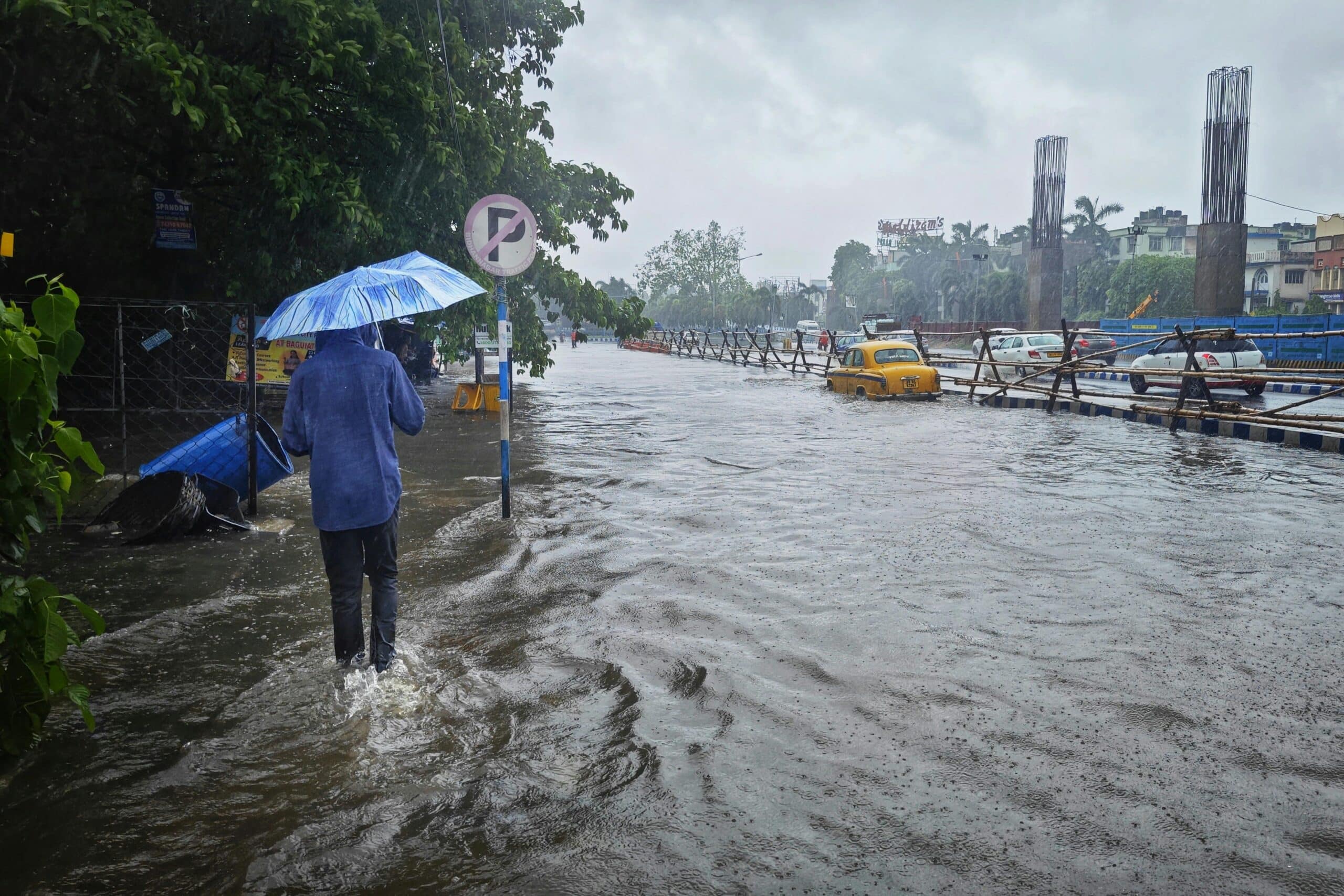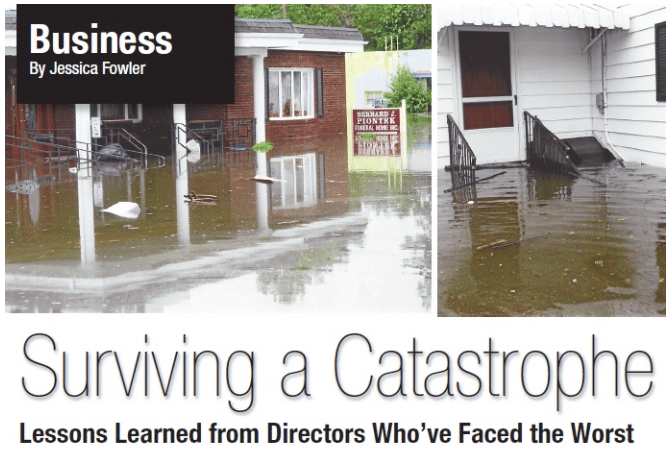
This article was originally published in the May 2013 issue of American Funeral Director by ASD Staff Writer Jessica Fowler.
Surviving a Catastrophe
Lessons Learned From Directors Who’ve Faced the Worst
For almost 100 years, the Denis S. O’Connor Funeral Home has stood firm against every hurricane, blizzard and flood that has hit the Rockaway Penisula in Queens, NY. As a third generation funeral director, Vincent O’Connor is no stranger to planning in advance. His funeral home was fully stocked with emergency supplies, but no amount of preparation could have spared him from the devastating effects of Hurricane Sandy, which nearly wiped the Rockaway peninsula off the map.
“We’ve had hurricanes, we’ve had interruptions but this was a historic event. This was unprecedented,” O’Connor says. “No one could have predicted that surge—14 feet of water in lower Manhattan! Everyone was caught off guard. There are certain things you can do but there are certain things you just can’t prepare for.”
Funeral directors understand the crucial need for intuition and foresight more than many professionals might. The unpredictable nature of death combined with the short window of time to plan a service requires that you be ready for any possible curveball. However, there are some scenarios that no business owner is ever fully prepared to encounter. When faced with a natural or man-made disaster, the survival of your funeral home is dependent on your reaction to changing circumstances. According to Federal Emergency Management Agency, 40 percent of small businesses never reopen their doors following a disaster.
Hurricane Sandy left the Denis S. O’Connor Funeral Home completely destroyed on the inside. The entire first floor was submerged in water. The firm’s rolling equipment, hearse and family car were flooded beyond repair. As the only funeral home on the Rockaway Peninsula, Denis S. O’Connor Funeral Home was needed more than ever after Hurricane Sandy. Residents were grieving both the loss of neighbors and the loss of a community that would never look the same. O’Connor soon realized they would need to adjust to their new situation as soon as possible in order to provide support to residents.
In the aftermath of a catastrophe, the resiliency of your funeral home depends both on your ability to plan in advance and your ability to adapt quickly. Here are some ways to guarantee your funeral home’s survival when the unthinkable occurs:
Develop a Recovery Plan
In the fallout of a major crisis, it may be difficult to think rationally and prioritize what needs to be done. Creating a Disaster Recovery Plan beforehand will provide you with a blueprint to follow if you’re ever faced with an emergency situation. According to Symantec’s 2011 SMB Disaster Preparedness Survey, more than 55 percent of small businesses have no recovery plan in place. There are a number of websites including FEMA.gov, PrepareMyBusiness.org and SBA.gov with detailed information on how businesses can prepare for specific weather events.
If you’re in a region that is prone to natural disasters, consider choosing vendors that are located outside of your local area to minimize the potential risk. For instance, in Florida very few funeral directors use a local answering service because hurricane could disable both the funeral home’s physical location and it’s ability to call forward. If you aren’t certain your funeral home is in an area at risk for natural hazards, contact your local building officer or zoning administrator for recommendations on protecting yourself. Regardless of your circumstances, there are certain preventative measures that all funeral home should take.
►Review your business insurance policy
Business owners may be blindsided when they learn their insurance coverage is not as comprehensive as they expected. A clear understanding of what your policy does and does not cover is essential to how you recover in an emergency situation. It will be impossible for you to properly budget your rebuilding costs if you are uneducated about your coverage. Flood insurance, for example, is not covered under property insurance and is only provided under the National Flood Insurance Program. Only 18 percent of Americans have flood insurance, according to Insurance Information Institute, despite the fact that it is the most common natural disaster in the United States.
“I think the best preparation is just to have good quality insurance and to read the small print on your policy because these insurance companies find a half dozen different ways to wiggle out,” O’Connor says.
Funeral Home owners may also have the option to add Business Interruption coverage. This extra protection covers the loss of revenue that a business suffers after an interruption caused by a disaster. However, it is crucial for policyholders to be aware that they can only tap into that insurance if the disruption continues for more than 72 hours, and only if the interruption is caused by direct physical damage to the property.
►Create an emergency contact list
Michelle Piontek had no warning that her family’s funeral home would flood during Tropical Storm Lee in September 2011. Located in Duryea, PA, The Bernard J. Piontek Funeral Home had never been affected by a flood during the firm’s 60-year history. But all that changed when the funeral home was unexpectedly inundated with nearly 3 feet of water after a levee was breached along the nearby Lackawanna River. More than 300 homes in the town were also flooded by the record-breaking storm.
“No one was prepared for this, we weren’t supposed to get flooded. Everyone was in the same boat as we were. All of the other neighbors were hit too,” Piontek says. “All you had to do is walk out your front door and there was someone who could help, which was a good thing because you didn’t know where to turn.”
Piontek credits the cooperative spirit of her community as a major reason for why she and her father were able to rebuild the funeral home in less than four months. She can’t imagine how they would have fared without the support of local residents who helped walk them through the process. The memory serves as a reminder for how the Pionteks will plan for the future.
“We have a record of all the phone numbers we need to call for everyone who helped—electricians, plumbers, remodeling companies. We keep it on file with costs and everything written down,” Piontek says. “I hope it’s something we never have to experience again but if it does happen, next time I’ll be prepared.”
If your funeral home were dealing with a similar hardship, what people, organizations and companies would you need to contact immediately? Who would you call first? Creating this list in advance will provide you with a sense of control and reduce the time it takes to get back on your feet after a disaster.
►Keep records backed up offsite
Technology has made it simpler than ever to safeguard your funeral home’s records. Yet, many business owners do not have sufficient redundancies in place to protect their file system. According to a July 2012 study conducted by Sage, the majority of small businesses are backing up key data but most businesses store that data on-site only. Back up copies of all critical records and store them offsite in a fire and waterproof safe so that no single event can wipe out your historical documentation.
“Make sure your files are protected and backed up because anything can burn,” says Brent Lyerly, president of the Lyerly Funeral Home. Lyerly learned this lesson firsthand after a fire broke out at his funeral home in Salisbury, NC last year. On Friday, April 13, 201, Lyerly turned on the furnace to warm up the funeral home before leaving with employees for lunch. When the staff returned, the building had filled with smoke and the funeral home was ablaze due to a furnace malfunction that quickly escalated into a four-alarm fire.
Looking back, Lyerly is deeply grateful that no one was injured and praised God for keeping everyone safe. The funeral home and everything inside was completely destroyed by the fire. During the reconstruction period, the Lyerly Funeral Home has remained open by using the building next door where Lyerly’s other business, Cremation Concepts, is located. However, the fire consumed many of the funeral home’s files and documents, delaying the process.
“You learn from anything that happens in life. In the new facility, we will have our files better protected and our building will have a sprinkler system to minimize possible damage,” Lyerly says.
Investing in a management system for your funeral home will allow you to store vital documents digitally so they can be accessed from any location. Cloud-based services such as Carbonite provide extra peace of mind by automatically backing up your files safely offsite and providing you with a web-based dashboard to easily access what you need from anywhere. This flexibility will reduce the time it takes for you to become operational again. At Denis S. O’Connor Funeral Home, it took more than 30 days to restore electricity to the Rockaway Peninsula. An employee who lived 20 miles north was able to find an Internet provider on the mainland so the funeral home could access crucial documents that were stored digitally.
“He operated the computer from there until we were able to get file service restored here,” O’Connor says.
Use Every Channel of Communication
After a major setback, information must be conveyed to the public instantaneously. If your funeral home’s operations are disrupted, effectively communicating with families, employees, vendors, clergy members and neighbors cannot be delayed. The firm’s reputation may be enhanced or tarnished by the public’s perception of how you respond to a crisis. By taking a proactive approach and transmitting information in a prompt and reliable format, your community will be more likely to come to your aid, rather than assume the worst.
►Keep Phone Lines Call Forwarded
Your funeral home’s telephone is the first point of contact for both the families you serve and those that may need to convey vital information during and after a disaster. Keeping open lines of communication is essential. Even when there is no apparent threat, a windy day or a quick bolt of lightening has the potential to knock out phone lines in an instant. By communicating call forwarding instructions to your phone company, you can protect your phone 24/7 during a power disruption. Call forwarding can ensure that your phone line automatically forwards to another number if you don’t answer by a specified number of rings.
During Hurricane Sandy, wind and flooding created outages and disruptions for all four of the major cell phone companies. According to O’Connor, cellular issues continued long after the storm because of damaged towers and an overflow of outgoing calls. Relying solely on cellular technology after a catastrophe may cost you the trust of a family your firm has served for generations. Call Forwarding lines to an answering service instead of your cell phone is a more secure way to remain in contact with your community in the aftermath of a disaster. O’Connor recommends our answering service, ASD – Answering Service for Directors.
“ASD can play a big part in trying to mitigate the immediate impact of an event,” O’Connor says.
Like O’Connor, Piontek also relied on ASD after her funeral home was flooded: “We let all of the calls go to the answering service and then they called me on my phone directly,” she says. If your funeral home’s phone lines were compromised, what steps would you take to ensure families could reach you?
►Broadcast Information Online
During an emergency, remaining connected to your community is critical. Your funeral home’s website, email list and social sites allow you to transmit a message to more people than any other form of communication. Even if you are without Internet service at the funeral home, there is likely still a way to post a message online. A large web-hosting company like FrontRunner Professional will have the resources available to quickly update your site and let visitors know what is happening at the funeral home.
When the Denis S. O’Connor Funeral Home learned that power had been restored in other areas of New York, employees left the peninsula to access the Internet. If you are able to travel and can go outside of the affected area, tap into an open network so that you can keep your community up-to-date on the latest developments.
Establish a social presence for your funeral home to reassure residents that you’re okay. You can provide temporary contact information and communicate details about delayed or cancelled services. Even if your funeral home’s social sites do not have many followers, those who are connected are likely to pass along the information. During Hurricane Sandy, social networks were full of posts from funeral homes and other businesses alerting their followers how they were handling the storm
“We are always here for you our phones are being answered by our answering service, and they will reach us. We pray that everyone remains safe,” wrote Francis P. Devine on their Facebook page. Located in Oyster Bay, New York, the funeral home owners didn’t know how hard it would be hit by the hurricane but wanted to relay as much information as possible to followers. The next day, the firm updated again to confirm a mass was still on schedule and offered rides to anyone who couldn’t travel. Later that week, owner Karen Devine used the Facebook page to organize a clothing drive for residents of Breezy Point.
Others used their social sites once the storm had passed to thank residents and keep the community up-to-date on their reconstruction. On November 8th, Chubenko Funeral Home posted a heartfelt letter on their Facebook page after Hurricane Sandy flooded their Port Reading, NJ location: “Your kind words, inspiration and offers to help are truly appreciated. We have been working around the clock to get our funeral home open as soon as possible and thankfully we are almost finished.” The letter went on to thank individual groups and organizations that were instrumental in helping the funeral home recover.
►Get the Word Out Through All Available Channels
There are some events so unimaginable that no amount of planning can prepare you for what to expect. After Hurricane Sandy, Denis S. O’Connor Funeral Home was forced to think outside the box to remain in contact with the community. When the power went out, the funeral home initially diverted lines to ASD and used their cell phones to access messages. Then, a 4-foot surge of water rose over the bulkhead and into the streets, submerging the local Verizon switching station.
“At that point, we lost all forwarding capability. So, we immediately printed letters expressing our regrets to everyone over what happened and distributed them at churches, emergency centers, police stations and firehouses,” O’Connor says. The posters included the 1-888 number the funeral home used to forward their lines to ASD. Callers who needed the funeral home would call the answering service directly while O’Connor and the other directors checked in for messages.
“We then began to print posters for the outside of our building. Anywhere our business appeared online, we changed the number to that 888 number. So people called directly to our answering service,” O’Connor says. “We appreciate ASD when you have an event like this because you have that resource so were not losing total communication with our community.”
When there is an isolated incident that adversely impacts an individual funeral home but not the entire community, it is essential for the owner to play a major role in broadcasting information to the public. For the Lyerly Funeral Home, it was critical that residents understood that the fire had destroyed the building but not the business. The town of Salisbury, NC is a tight-knight community where word of mouth spreads quickly. Lyerly devised a way to ensure everyone in town was on the same page.
“From April until the Fall, we ran a big Sunday advertisement in the paper to keep everyone abreast of what was going on,” Lyerly says.
Rebuild With A Vision
A catastrophic event may close certain doors forever, but it also has the potential to unlock new possibilities. Finding a silver lining can be a challenge for funeral home owners that cannot see past the remains of their damaged or destroyed facility. In order to move beyond a crisis, you will need to focus a great deal of your attention on what you want your funeral to look and feel like after it is rebuilt.
Brainstorm ideas for how to offer more to families with a new or renovated facility. Is there anything about your current location that you would update if you could? Changes that may not have been possible before—such as creating a skylight, constructing a handicap access ramp or rewiring electric lines—may no longer be an issue after a disaster. If you look at the situation as an opportunity instead of a calamity, your mind will be open to innovative and fresh ideas for how to renovate your funeral home. Do not make it a goal to duplicate the exact same look and style of your old building because you will only be disappointed if the result is not a carbon copy. Instead, consider ways you might be able to enhance a family’s experience with a newly remodeled facility.
The new Lyerly Funeral Home will look very different from the old building, which was originally constructed in 1964. The new facility, which Lyerly hopes will open in the next several months, will be modernized with contemporary features and better protected from future disasters. There will be a sprinkler system and multiple safety exits should another fire occur. New family rooms and In addition to these changes, it was crucial for Lyerly to look ahead to the future when redesigning his facility.
“We will put more emphasis on what I see as the future of the funeral industry,” Lyerly says. “There will be a lot of focus on audio and visual elements.”
Article Reprint:
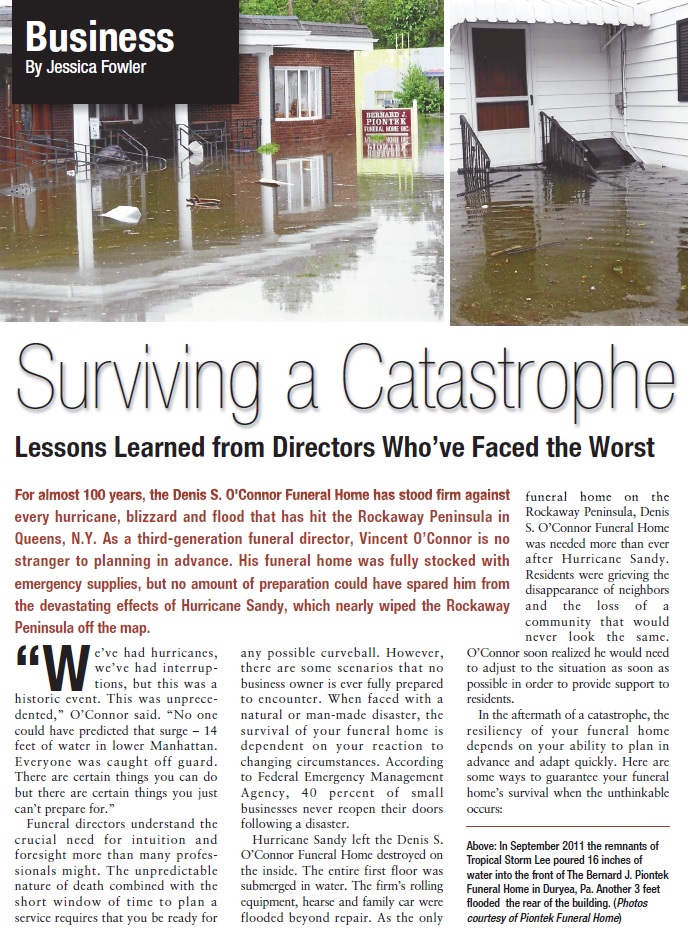
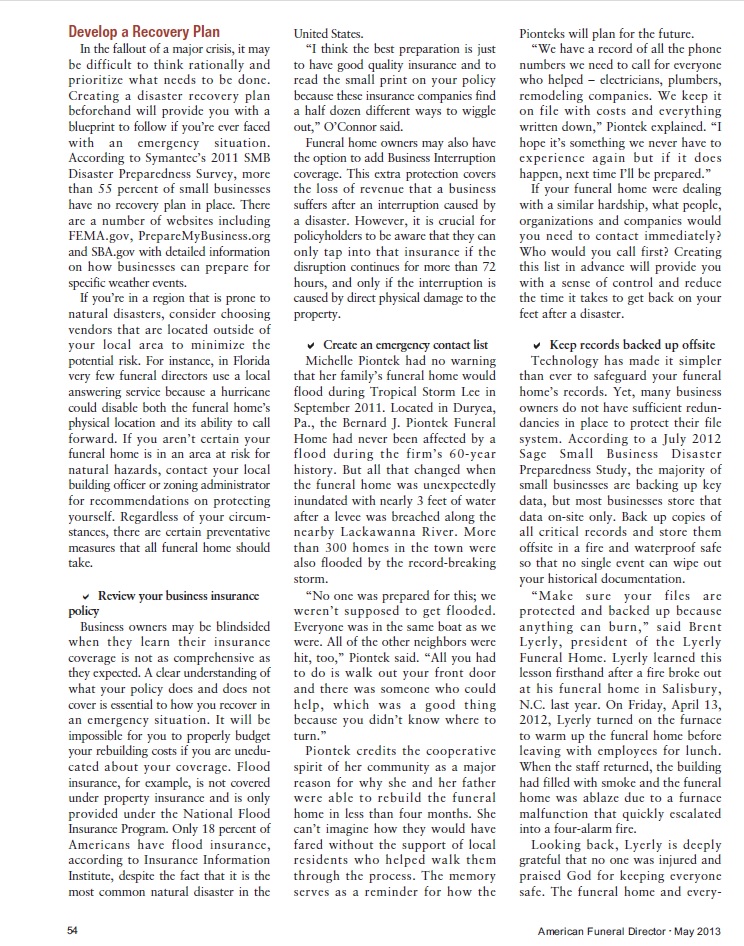
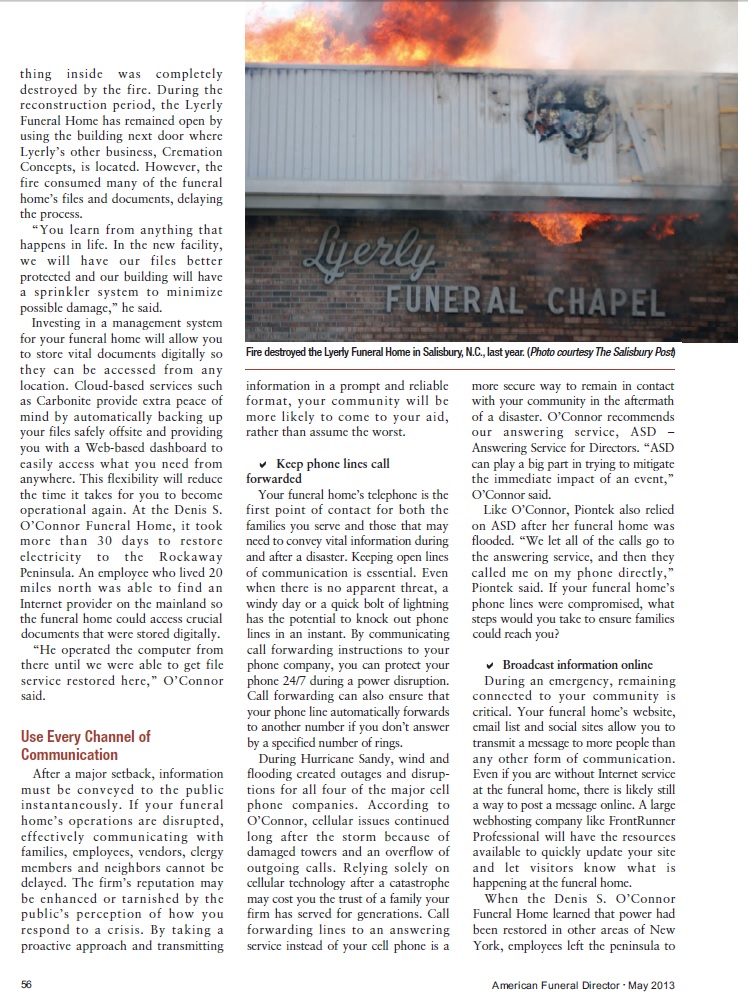
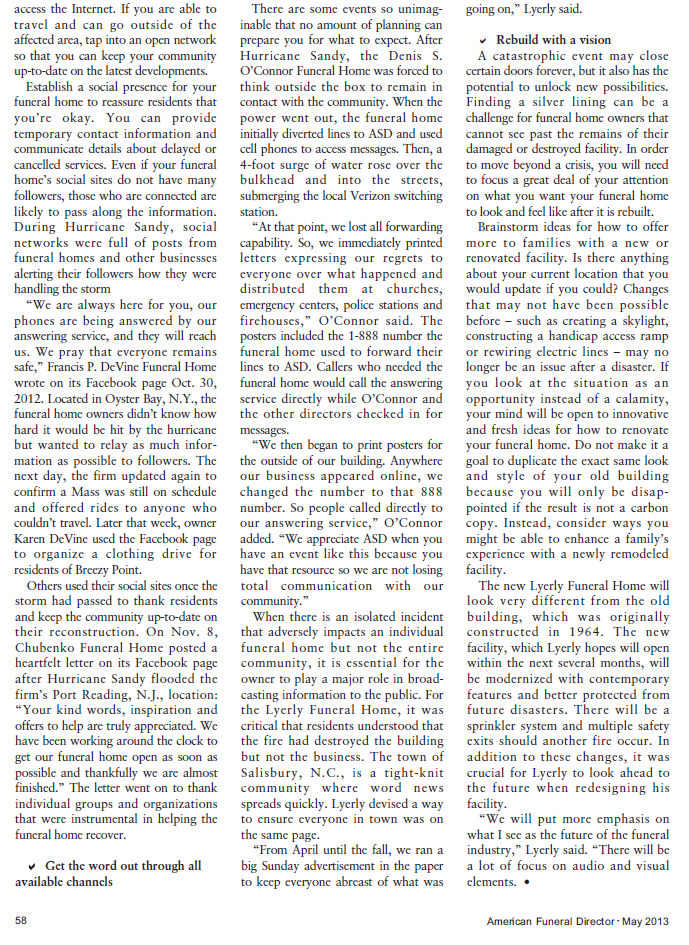
About The Author
Jess Farren (Fowler)
Jess Farren (Fowler) is a Public Relations Specialist and Staff Writer who has been a part of the ASD team since 2003. Jess manages ASD’s company blog and has been published in several funeral trade magazines. She has written articles on a variety of subjects including communication, business planning, technology, marketing and funeral trends. You can contact Jess directly at Jess@myASD.com
